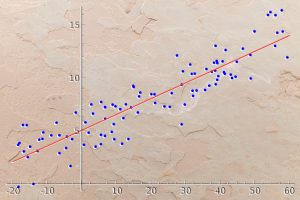This article is a guide for beginners in Artificial Intelligence who want to start studying Deep Learning.
How could one not have heard of Artificial Intelligence in our times?
From ChatGPT and AlphaFold to autonomous cars, and even Midjourney, it is clear today that AI is no longer science fiction.
Behind this technology lies a field of computer science that Isaac Asimov, Steven Spielberg, or James Cameron could not have imagined: Deep Learning.
Deep Learning now enables the creation of the most powerful Artificial Intelligence algorithms. Knowing this field means mastering the gears ⚙️ that will shape tomorrow’s technologies.
That’s why I offer you a guide here to start studying Deep Learning – right now.
The Basics of Deep Learning
To begin studying Deep Learning, it is crucial to understand its foundations.
Definition and Key Concepts
Deep Learning is an approach to Machine Learning that uses vast amounts of data to train complex models to solve a task.
At the core of this approach are artificial neural networks, inspired by human neural networks.
These networks consist of layers of neurons. Each layer learns specific aspects of data, ranging from simple features to increasingly complex concepts.
When trained, Deep Learning models can:
- Recognize trends
- Perform classifications
- Generate information
- Make predictions
- And much more
Difference between Deep Learning, Machine Learning, and Artificial Intelligence
Although these terms are often used interchangeably, they are not identical.
Artificial Intelligence is a broad field aimed at creating machines capable of performing tasks that would normally require human intelligence.
Machine Learning is a subcategory of AI. It allows algorithms to perform tasks by being exposed to data and by experimenting with it.
Deep Learning, on the other hand, is a more specialized subcategory of Machine Learning. It uses neural networks to create powerful models through large amounts of data.
Thanks to Deep Learning, it is possible to create Artificial Intelligence models that use Machine Learning to perform complex tasks.
In your exploration of this field, some knowledge and prerequisites will be assets.
Prerequisites for Studying Deep Learning
Two fundamental aspects need to be considered before delving into the world of neural networks.
Programming Basics (Python Recommended)
Proficiency in a programming language is fundamental for exploring Deep Learning.
Python is widely recommended in this field for several reasons:
- The syntax is clear
- There are various libraries dedicated to Deep Learning
- The user community is large
- GPU parallelization is easy
I recommend having at least basic knowledge of Python.
For example, understanding data structures, loops, conditions, and functions is essential. It is also ideal, though not mandatory, to be familiar with Object-Oriented Programming concepts.
Knowledge of Machine Learning
Contrary to popular belief, it is not necessary to master all Machine Learning principles to start with Deep Learning.
However, an understanding of metrics used to evaluate Machine Learning models is crucial.
Metrics such as accuracy, recall, or F1 score allow for evaluating the performance of AI models. I have written a dedicated article on these metrics that you can consult on this link.
Mastering these metrics enables model refinement, interpretation of their results, and making informed decisions when optimizing algorithms.
By possessing these prerequisites, you ensure that you have solid foundations for your journey.
Choosing the Right Development Environment
One of the key steps to start your Deep Learning journey is to choose a suitable development environment.
This decision not only influences how you interact with Deep Learning algorithms but also the ease with which you can test, modify, and improve your models.
For this, you will need to choose an appropriate framework for your needs and set up your work environment properly.
By the way, if your goal is to master Deep Learning - I've prepared the Action plan to Master Neural networks. for you.
7 days of free advice from an Artificial Intelligence engineer to learn how to master neural networks from scratch:
- Plan your training
- Structure your projects
- Develop your Artificial Intelligence algorithms
I have based this program on scientific facts, on approaches proven by researchers, but also on my own techniques, which I have devised as I have gained experience in the field of Deep Learning.
To access it, click here :
Now we can get back to what I was talking about earlier.
Introduction to Popular Frameworks
- Keras
Keras is a high-level Deep Learning framework known for its simplicity and accessibility for beginners. It serves as an interface for TensorFlow, allowing you to build and test Deep Learning models with less code and complexity. Keras is ideal for those starting their Deep Learning practice. - TensorFlow
Developed by Google, TensorFlow is one of the most widely used frameworks in the field. It offers great flexibility and precise control over Deep Learning models, making it suitable for both research and production. TensorFlow is recommended for those with some experience in programming and machine learning. - PyTorch
Developed by Facebook, PyTorch is also popular, especially among researchers due to its flexibility. Its main advantage lies in its ability to facilitate dynamic computations, allowing for intuitive experimentation. PyTorch is often preferred for experimental projects and research.
Setting Up the Development Environment
- Choosing a Code Editor – IDE or Notebook
To write your Python code and test Deep Learning models, you will need a code editor. Integrated Development Environments (IDEs) like PyCharm or Visual Studio Code offer comprehensive features for development. However, a popular option (which I recommend) is the notebook, such as Jupyter or Colab. They are perfect for interactive experimentation and data visualization. - Installing Python and Necessary Libraries
Make sure you have the latest version of Python installed on your computer. Then, you can use package managers like pip to install libraries useful for data processing (NumPy, Pandas, Matplotlib). - Selecting and Installing a Framework
Depending on your skill level and needs, choose between Keras, TensorFlow, or PyTorch. Each framework has its own specific installation instructions, usually well-documented on their respective websites. If you are a beginner, I recommend starting with Keras. - Testing Your Installation
After installation, run a simple script or notebook to check that everything is working correctly. For example, you can import the libraries you have installed and perform basic operations.
Practice is the key to knowledge 🚀, so it is essential to have the appropriate environment to take action!
By selecting the right framework and carefully configuring your development environment, you ensure a smoother and more productive learning experience.
Practical Projects and Applications of Deep Learning
To solidify your understanding of Deep Learning and develop practical skills, there is nothing more effective than working on real projects.
This part of your journey is essential. It will allow you to test the concepts you have learned and explore the vast applications of this technology.
Beginner Project Suggestions
- Image Classification
Start with a simple project like image classification using public datasets like MNIST or CIFAR-10. This will help you understand how neural networks process and categorize images. - Sentiment Analysis
Use Deep Learning to analyze sentiment in texts, such as product reviews or tweets. This will introduce you to Natural Language Processing (NLP). You can directly check out an NLP classification tutorial I’ve created by clicking on this link. - Automatic Text Generation
Create a model capable of generating text, such as poems or short stories, based on a dataset of textual data. - Speech Recognition
Try to build a model that recognizes simple words or phrases. Datasets like Google Speech Commands can be a good starting point. - Object Detection
More advanced, this project involves identifying and locating objects in images. Frameworks like YOLO (You Only Look Once) can be explored for this type of task.
Once you have practically mastered these concepts, you will be better equipped to understand how neural networks are used in real-world applications.
Examples of Real-World Deep Learning Applications
- Autonomous Vehicles: Deep Learning algorithms enable autonomous cars to recognize surrounding objects, make decisions, and navigate safely.
- Medical Diagnosis: Deep Learning is used to analyze medical images, helping to detect diseases like cancer earlier and with greater accuracy.
- Voice Assistants: Products like Alexa or Siri use Deep Learning to understand natural language and respond to user queries.
- Automatic Translation: Services like Google Translate leverage Deep Learning to translate text or speech in real-time between different languages.
- Fraud Detection: In the financial sector, Deep Learning is employed to identify suspicious activities and prevent fraud.
By working on practical projects and understanding how Deep Learning is applied in the real world, you will be better prepared to tackle complex problems and contribute to innovative solutions in these domains!
Finally, to sharpen your Deep Learning knowledge, you can also learn from experts studying and working in this field.
Studying Resources for Deep Learning
To make effective progress in studying Deep Learning, you can rely on the numerous resources that already exist.
These resources not only offer theoretical knowledge but also opportunities for interaction with other enthusiasts and experts in the field.
Forums, Discussion Groups, and Social Networks
Online forums and discussion groups are excellent places to ask questions, share knowledge, and solve problems.
Platforms like Stack Overflow, Reddit (in subforums dedicated to Deep Learning and AI), and LinkedIn groups provide space for constructive discussions and peer support.
Social networks like X can also be an effective way to stay informed on the latest trends and research in Deep Learning.
It is crucial to be up to date with developments in Deep Learning as innovations are emerging almost every week. Following experts and institutions in this field can provide valuable insights.
I encourage you to follow the personalities and institutions you already know and appreciate! You can also follow my website, Inside Machine Learning, on X by clicking here to stay informed about my latest articles.
Books, Tutorials, Video Workshops, Online Courses
While staying current with developments in neural networks and Artificial Intelligence in general is good, if you are just starting to study Deep Learning, you need to grasp the basics.
There are already numerous resources on the subject.
Books written by experts in the field that cover the basics and advanced concepts of Deep Learning.
Blogs and specialized websites that offer tutorials, in-depth articles, and explanations of complex concepts. Don’t hesitate to explore Google to find answers to the questions you have.
Personally, I offer articles covering various topics that you can read here.
If you prefer online videos, you can check out YouTube, which is filled with tutorials, conferences, and free courses hosted by professionals and educators.
There are also many institutions and online education platforms offering courses covering various aspects of Deep Learning.
These courses vary in terms of difficulty, duration, and specificity, and often come with practical projects and exams to assess your progress.
Myself, on Inside Machine Learning, I offer online courses for mastering Deep Learning.
I precisely offer one on neural networks that will allow you to:
- Plan your training
- Structure your projects
- Develop your Artificial Intelligence algorithms
If you want to deepen your knowledge in the field, you can access my Action plan to Master Neural networks.
A program of 7 free courses that I have prepared to guide you on your journey to master Deep Learning.
If you’re interested, click here:
One last word, if you want to go further and learn about Deep Learning - I've prepared for you the Action plan to Master Neural networks. for you.
7 days of free advice from an Artificial Intelligence engineer to learn how to master neural networks from scratch:
- Plan your training
- Structure your projects
- Develop your Artificial Intelligence algorithms
I have based this program on scientific facts, on approaches proven by researchers, but also on my own techniques, which I have devised as I have gained experience in the field of Deep Learning.
To access it, click here :




